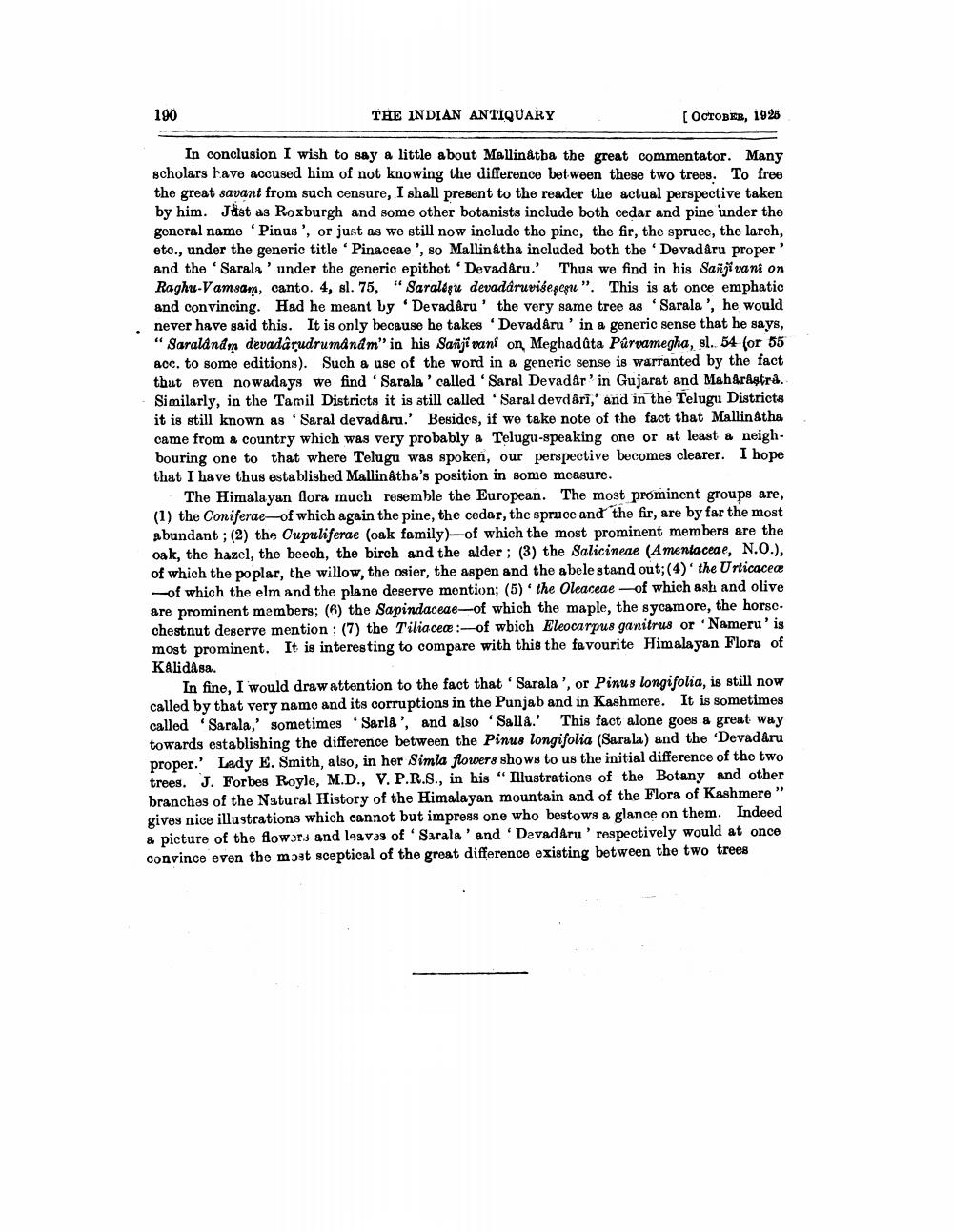________________
190
THE INDIAN ANTIQUARY
[OCTOBER, 1926
In conclusion I wish to say a little about Mallinåtba the great commentator. Many scholars have accused him of not knowing the difference between these two trees. To free the great savant from such censure, I shall present to the reader the actual perspective taken by him. Jást as Roxburgh and some other botanists include both cedar and pine under the general name 'Pinus', or just as we still now include the pine, the fir, the spruce, the larch, etc., under the generic title 'Pinaceae ', so Mallinatha included both the Devadaru proper' and the 'Sarala 'under the generic epithet 'Devadaru.' Thus we find in his Sanjivani on Raghu-Vamsam, canto. 4, sl. 75, "Saraléşu devadáruviseger". This is at once emphatic and convincing. Had he meant by Devadaru' the very same tree as 'Sarala', he would never have said this. It is only because he takes 'Devadaru ' in a generic sense that he says, "Saralandm devadarudrumandm" in his Sañji vani on Meghadâta Púrvamegha, sl. 54 for 55 acc. to some editions). Such a use of the word in a generic sense is warranted by the fact that even nowadays we find 'Sarala' called 'Saral Devad&r' in Gujarat and Maharastra. Similarly, in the Tamil Districts it is atill called 'Saral devdari,' and in the Telugu Districts it is still known as 'Saral devad Aru.' Besides, if we take note of the fact that Mallinatha came from a country which was very probably a Telugu-speaking one or at least a neighbouring one to that where Telugu was spoken, our perspective becomes clearer. I hope that I have thus established Mallinatha's position in some measure.
The Himalayan flora much resemble the European. The most prominent groups are, (1) the Coniferae of which again the pine, the cedar, the spruce and the fir, are by far the most abundant; (2) the Cupuliferae (oak family)-of which the most prominent members are the oak, the hazel, the beech, the birch and the alder; (3) the Salicineae (A mentaceae, N.O.), of which the poplar, the willow, the osier, the aspen and the abele stand out;(4) the Urticaceæ
-of which the elm and the plane deserve mention; (5) the Oleaceae - of which ash and olive are prominent members; (6) the Sapindaceae-of which the maple, the sycamore, the horsechestnut deserve mention : (7) the Tiliacere :-of wbich Eleocarpus ganitrus or Nameru' is most prominent. It is interesting to compare with this the favourite Himalayan Flora of KAlidåsa.
In fine, I would draw attention to the fact that 'Sarala', or Pinus longifolia, is still now called by that very name and its corruptions in the Punjab and in Kashmere. It is sometimes called 'Sarala,' sometimes 'Sarla', and also 'Salla.' This fact alone goes a great way towards establishing the difference between the Pinus longifolia (Sarala) and the 'Devadaru proper.' Lady E. Smith, also, in her Simla flowers shows to us the initial difference of the two trees. J. Forbes Royle, M.D., V. P.R.S., in his "Illustrations of the Botany and other branches of the Natural History of the Himalayan mountain and of the Flora of Kashmere" gives nice illustrations which cannot but impress one who bestows a glance on them. Indeed a picture of the flowers and leaves of 'Sarala' and 'Davadaru 'respectively would at once convince even the most sceptical of the great difference existing between the two trees




